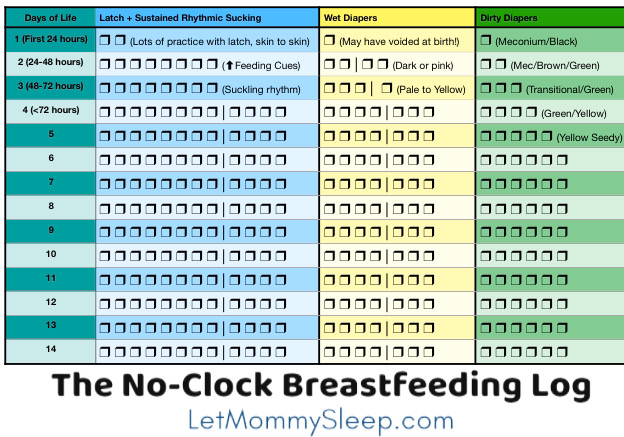The NoClock Nursing Method
There’s a LOT of advice about how long and how much a newborn should be breastfeeding so the No Clock Method might sound a little funny. But as Heidi Streufert, RN, BSN and former La Leche League Leader explains: “My best advice to postpartum parents is to throw away the clock at least for the first few weeks. While establishing milk supply, watch the baby’s natural eating and sleeping patterns to emerge.” Heidi explains the NoClock Nursing Method here.
Why it Matters and How to Make Sure Baby is Feeding Enough
The NoClock Method works because it focuses on your baby’s cues, not A Schedule. This supports milk supply, ensures adequate feeding frequency, and helps parents learn their baby’s hunger and satiety signals naturally. To assure baby is feeding often enough, rather than thinking in terms of “feeding every __ hours for ____ minutes,” simply make a check mark for each successful latch with sustained rhythmic sucking during a 24 hour period. You can use this chart.
Additionally research from the American Academy of Pediatrics, La Leche League and many others supports on-demand feeding during the newborn period to help establish milk supply and ensure healthy weight gain.

Each attempt may *realistically* last anywhere from as long as 45 minutes to as short as 5 (yes five!) minutes for an active full term baby. A longer attempt of 45 minutes or so might occur in a dyad where there are repeated latch attempts, or when supply hasn’t yet met demand. This is common in the early days. Shorter attempts at feeding will happen with a good deep latch and adequate supply/fast let-down in mom.
The key is to allow baby to spontaneously release the breast and burp. Then offer the second breast if baby still interested but there’s no need to worry about “how long” baby was on the breast.
At a minimum, baby should have 8 such occurrences in a 24 hour period. Some babies will have 10-12 or more of these breastfeeding sessions on any given day. This is perfectly normal, especially when establishing supply or during growth spurts. Labor & Delivery RN Meghan Becker explains:
NoClock Nursing Method in “Clock” Terms
Here’s what we mean when we put this in “Clock Terms:”
- Babies -newborns especially – typically feed MORE often than every 3 hours throughout the day.
- They can often have a slightly longer stretch of sleep between feeds overnight.
- Either way, a pattern will emerge in the first two weeks that can be made into the ‘routine’ once supply is well-established.
Baby’s urine and stool output will be the guide if you’re wondering if your newborn is eating enough. You can see a wet and soiled diaper chart and answer the question, how big is a newborn’s stomach here. This can again be a simple check mark at each diaper change. We have a NoClockLog above, but any piece of paper will do- too much focus on exact recording isn’t needed!
NoClock Nursing Method – Breastfeeding to Sleep
When parents ask me if it’s okay to let their baby fall asleep at the breast, I usually respond, “I dare you to try to keep them awake!” says Heidi, RN.
“But, seriously, I typically tell them that newborns will fall asleep while breastfeeding. Not only is this okay, but parents will soon discover that the breast is a wonderful tool. Nursing is so much more than a way to feed our babies!”
There are parents who are concerned that nursing to sleep will set the baby up with “bad habits.” Don’t worry- the only rule is just that nursing should not serve as the only tool for putting baby to sleep. Just as the pacifier, rocking or sleeping in the car should not be the only ways baby knows to go to sleep.
Shouldn’t We Have a Routine?
Sometimes baby falls asleep at the breast, but sometimes baby nurses, plays a little while, then has a bath. Then they get a swaddle, or parents sing, rock, or walk baby to sleep. Sometimes the baby falls asleep traveling in the car (no one EVER seems to suggest that THIS is a problem!). Sometimes your baby will slip off to sleep while you’re holding them and other times the crib. The key is flexibility. This sets baby up to be able to sleep in a variety of situations, rather than always relying on just one association for sleep. So no, parents don’t have to worry about breastfeeding to sleep.
While establishing a good bedtime routine is important for babies during the first year, being too rigid can lead to its own set of problems. Babies who have a very strict sleep routine may have difficulty with sleep issues later when it’s time to transition to a new bed, sleep on vacation, or take a nap at grandma’s house. Of course they may not either, and we understand needing baby to nap. The point is to ensure your baby isn’t solely dependent on one specific way to go to sleep.
Written and medically reviewed by Heidi Streufert, RN, BSN, former La Leche League Leader. Reviewed for accuracy by Meghan Becker, RN, Labor & Delivery Nurse.
Categories
- Corporate Care & Partners
- COVID19 Archive
- En Espanol
- Expert Guides
- Hiring a Night Nanny
- Infant Safety
- Infant Sleep Hub
- Newborn Care
- Postpartum Health
- Twins & Multiples
- Work as a Night Doula
- zPost Archives
